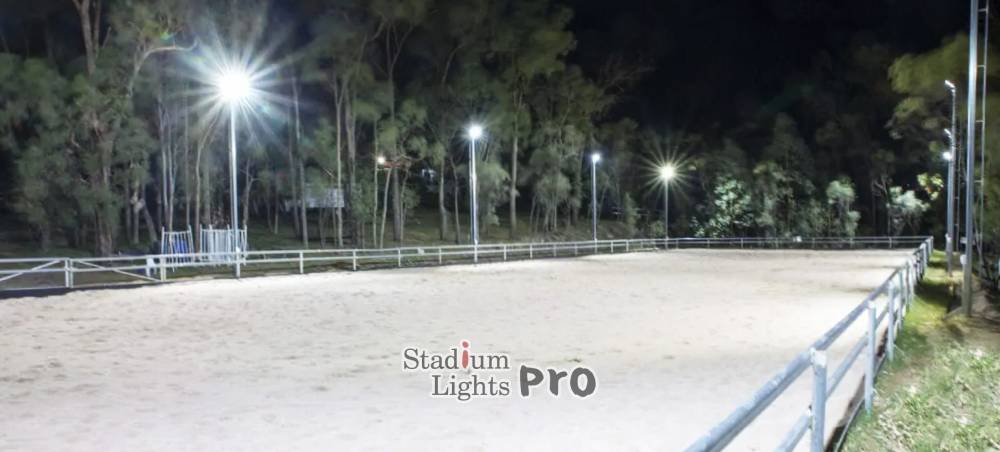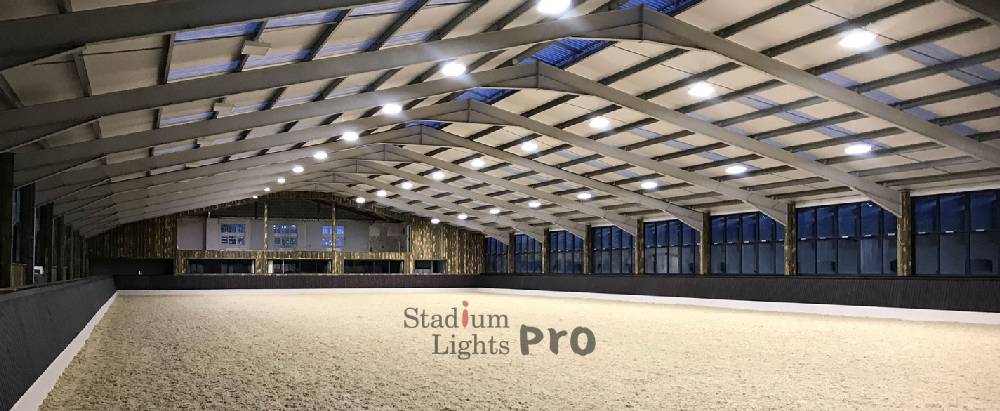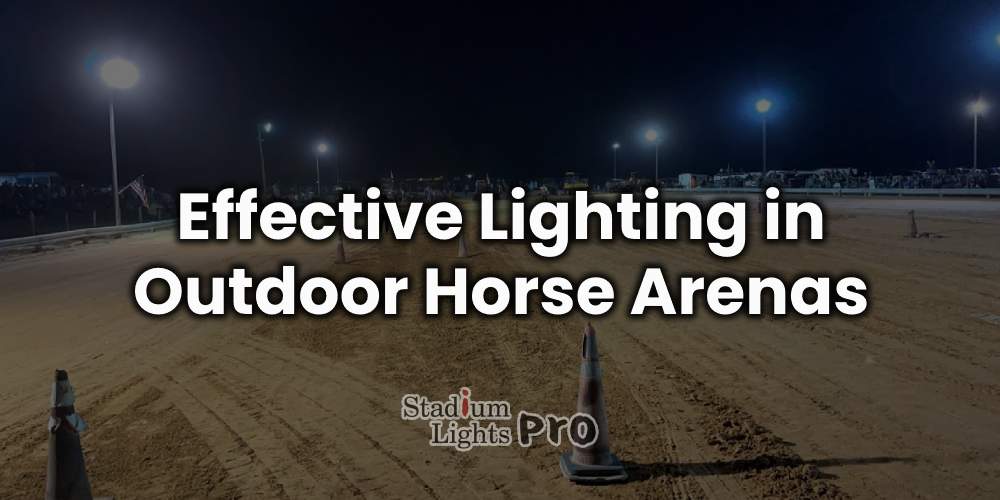Well-designed lighting systems not only provide clear and consistent illumination, extending the arena’s usability beyond daylight hours, but also contribute to a conducive atmosphere for training and competition. This requires adherence to established lighting standards to ensure appropriate illuminance, uniformity, and glare control, while also considering environmental factors such as local climate, moisture, and dust exposure.
Table of Contents
ToggleLighting Standards for Outdoor Horse Arenas
Lighting Standards

Lighting standards for outdoor horse arenas are meticulously formulated to ensure that illumination is both effective and safe for all users. These standards encompass several critical aspects, including illuminance levels, uniformity, and glare control. Proper adherence to these standards is fundamental in creating an environment that supports the needs of training and competitive activities while prioritizing safety. The primary goal of these standards is to provide a lighting system that prevents accidents, enhances visibility, and ensures that both horses and riders can perform with confidence and ease. By following these guidelines, arenas can achieve a balance between functionality and safety, contributing to a more enjoyable and productive experience.
Recommended Illuminance Levels
For outdoor horse arenas, recommended illuminance levels typically range from 100 to 300 lux. This spectrum of brightness is designed to accommodate various equestrian activities such as riding, jumping, and dressage, ensuring that the arena is sufficiently illuminated for all required tasks. The choice of illuminance level within this range may depend on factors such as the specific type of activity, the size of the arena, and the time of day when events or training sessions occur. For instance, higher lux levels may be necessary for competitive events or detailed training exercises, while lower levels might suffice for general practice or leisure activities. Balancing these levels is crucial to avoid excessive glare and shadow, which can impede visibility and affect performance.
Uniformity and Glare Control
Uniformity in lighting is essential to ensure that the entire arena is consistently illuminated, preventing unevenly lit areas that can pose hazards to both riders and horses. A well-designed lighting system should strive to minimize shadows and bright spots, which can distract or disorient equestrians and their mounts. Achieving this uniformity involves careful placement and angling of light fixtures to ensure an even distribution of light across the arena. Additionally, glare control is a critical component of effective lighting design. Glare can arise from direct light sources or reflections, causing discomfort and potential safety issues. Effective glare control measures, such as using diffusers or adjusting light angles, help mitigate these problems, providing a more comfortable and safe environment for all users.
Designing Effective Lighting for Outdoor Horse Arenas
Assessing Arena Requirements
Designing an effective lighting system for an outdoor horse arena begins with a thorough assessment of the arena’s specific requirements. This involves evaluating several key factors, starting with the size and shape of the arena. Understanding the dimensions of the space—whether it is an oval, rectangular, or custom shape—helps in determining the appropriate number and placement of light fixtures. The typical activities conducted within the arena, such as riding, jumping, or dressage, also influence the lighting design. Each activity may require different levels of brightness and illumination quality to ensure optimal performance and safety.
Furthermore, it is essential to account for any special needs related to competitions or training events. These may include increased lighting levels for higher visibility during night-time events or specific lighting arrangements to highlight particular areas of the arena. Additionally, considering the surrounding environment is crucial. Factors such as neighboring properties, which could be affected by light spill, and natural features, such as trees or hills that might obstruct light, play a significant role in the lighting design. By taking these elements into account, one can ensure that the lighting system is both functional and considerate of the broader context.
Choosing the Right Light Fixtures
Selecting the appropriate light fixtures is a critical step in achieving both visibility and ambiance in an outdoor horse arena. High-quality LED floodlights are often the preferred choice due to their superior efficiency and durability. LED technology offers several advantages over traditional lighting options, including longer lifespans, which reduce the frequency of replacements and associated maintenance costs. Additionally, LED floodlights are capable of providing bright, even illumination, essential for creating a well-lit environment across the entire arena.
The choice of fixtures should also be guided by their ability to withstand outdoor conditions. Fixtures must be designed to endure exposure to elements such as rain, snow, and extreme temperatures. Features such as weather-resistant housings and robust construction ensure that the lighting system remains operational and reliable over time. When selecting fixtures, it is also important to consider their energy efficiency. Energy-efficient lighting not only reduces operational costs but also contributes to environmental sustainability.
Placement and Angling of Lights
The effective placement and angling of light fixtures are vital to achieving uniform illumination and minimizing shadows within the arena. Lights should be strategically positioned around the perimeter of the arena to ensure comprehensive coverage. The height at which fixtures are installed is also a crucial consideration; fixtures mounted too low may create unwanted shadows, while those positioned too high may not provide adequate illumination. Typically, a height that balances coverage with intensity is preferred, often involving mounting fixtures on poles that can be adjusted to the optimal height.
The angling of the lights is equally important to control glare and prevent direct light from disrupting the experience of riders and horses. Properly angled fixtures help to direct light evenly across the arena while minimizing glare and avoiding direct illumination into the eyes of participants. Achieving this balance often involves a combination of adjusting the tilt and orientation of the fixtures. In practice, this might mean using a mix of fixture types and pole heights to fine-tune the lighting conditions for various parts of the arena.
Factors to Consider in Lighting Design

Color Temperature
The color temperature of lighting significantly influences both visibility and ambiance in outdoor horse arenas. For optimal performance, a color temperature between 4000K and 5000K is typically recommended. This range provides a neutral white light that enhances contrast and clarity without skewing colors, which is crucial for activities that require accurate visual assessment, such as riding, jumping, and dressage. Neutral white light ensures that colors are perceived correctly and that details are clearly visible, which is essential for both safety and performance.
On the other hand, warmer light temperatures, below 3000K, tend to create a softer, more inviting atmosphere. While this can enhance comfort and reduce harshness, it may not offer the necessary brightness and clarity required for detailed tasks and precise maneuvers. Conversely, cooler temperatures, above 5000K, produce a more clinical and stark light, which might not be as conducive to creating a comfortable and engaging environment for riders and spectators. The cooler light can sometimes lead to a sterile atmosphere that may detract from the overall experience, particularly during extended periods of use.
Environmental Considerations
Designing lighting for outdoor horse arenas requires careful consideration of various environmental factors. Given the exposure to diverse weather conditions—ranging from rain and snow to extreme temperatures—fixtures must be robust and resilient. To ensure longevity and consistent performance, it is essential to select lighting fixtures with high waterproof and dustproof ratings, such as IP65 or above. These ratings guarantee that the lights will remain operational and safe despite challenging environmental conditions.
Additionally, the design should account for the physical impact of vibrations and shocks, particularly in areas with heavy traffic or frequent maintenance activities. Fixtures that are built to withstand such stresses will reduce the likelihood of malfunction and extend the lifespan of the lighting system.
Energy Efficiency and Sustainability
Energy efficiency is a pivotal consideration in the design of lighting systems, influencing both operational costs and environmental impact. LED lights are highly recommended for outdoor horse arenas due to their superior energy efficiency compared to traditional lighting options. LEDs consume significantly less electricity, which not only reduces operational costs but also minimizes the carbon footprint of the arena. By implementing energy-efficient lighting solutions, stakeholders can contribute to a more sustainable environment while also benefiting from lower energy bills.
Maintenance and Durability
The durability and ease of maintenance of lighting fixtures are crucial factors in ensuring their long-term functionality. Outdoor horse arenas are subject to harsh conditions that can challenge the integrity of lighting systems. Therefore, it is essential to choose high-quality fixtures designed for durability and minimal upkeep. Opting for fixtures with extended lifespans and easy maintenance features helps reduce the frequency and costs associated with repairs or replacements. Additionally, regular maintenance should be planned to address any potential issues before they escalate, ensuring the lighting system remains effective and reliable.
Aesthetic Considerations
While functionality is paramount, the aesthetic impact of lighting should also be carefully considered to enhance the overall ambiance of the arena. Thoughtful lighting design can transform the arena into a visually appealing and welcoming space, positively affecting the experience of both riders and spectators. Incorporating features such as dimmable lights or color-changing capabilities allows for adaptability to different events and moods, providing flexibility to create the desired atmosphere. For instance, adjustable lighting can be used to highlight specific areas during competitions or to create a softer, more relaxed environment for practice sessions.
Implementing the Lighting Design
Planning and Installation
Once the lighting design for an outdoor horse arena has been finalized, meticulous planning and installation are imperative to ensure the system functions optimally and meets all specified requirements. Engaging a professional lighting designer or contractor is crucial at this stage to oversee the installation process. Their expertise ensures that the installation adheres to the design specifications and performs as intended. This includes meticulous tasks such as wiring the system, aligning and positioning fixtures accurately, and conducting thorough testing to verify that the lighting meets all performance and safety standards. Proper installation is fundamental to achieving the desired outcomes in terms of both visibility and ambiance, and it sets the foundation for the long-term success of the lighting system.
Testing and Adjustments
Following the installation, comprehensive testing of the lighting system under actual operating conditions is essential. This phase allows for the identification of any practical issues that may not have been apparent during the design and installation phases. Testing should encompass the assessment of light placement, angles, and intensity to ensure that the system delivers even illumination across the arena and minimizes any potential issues such as glare, shadows, or uneven light distribution. Adjustments may be required to fine-tune the system, such as repositioning fixtures, modifying angles, or adjusting brightness levels. Addressing these issues promptly ensures that the lighting system performs at its best, providing optimal conditions for both riders and horses.
Regular Maintenance
Ongoing maintenance is critical to ensuring the long-term effectiveness and reliability of the lighting system. Establishing a regular maintenance schedule is essential for keeping the system in good working order and preventing potential issues from escalating. This routine maintenance should include periodic inspections to check for any signs of wear or damage, cleaning fixtures to maintain optimal light output, and prompt repairs to address any malfunctioning components. Regular maintenance not only extends the lifespan of the lighting system but also ensures that it continues to meet performance standards and provides a safe, well-lit environment for the arena’s activities. By proactively managing maintenance tasks and addressing issues as they arise, stakeholders can preserve the integrity and functionality of the lighting system, ensuring its continued effectiveness and reliability.
Conclusion
A well-designed lighting system for outdoor horse arenas not only enhances visibility and extends usability beyond daylight hours but also fosters a conducive environment for training and competitive events. Adherence to established lighting standards ensures adequate illuminance, uniformity, and effective glare control, while considerations of environmental factors such as weather conditions and exposure to elements help in selecting durable, high-performance fixtures. Proper planning and installation, coupled with ongoing maintenance and periodic adjustments, are essential to maintain the system’s functionality and longevity. By integrating thoughtful design and practical considerations, arenas can achieve a balance between functionality and aesthetics, providing a safe, visually appealing space that supports both riders and horses in their activities.

